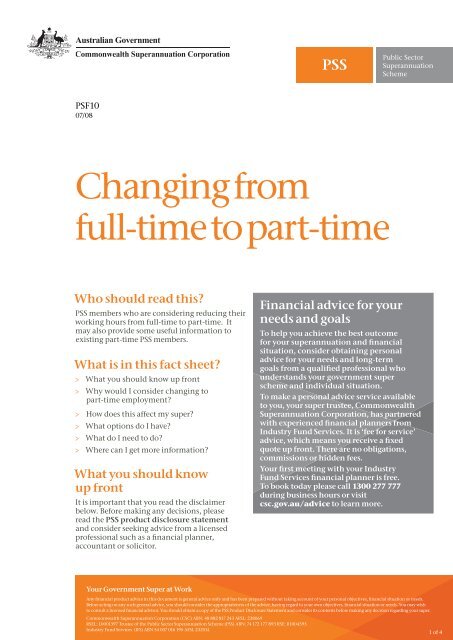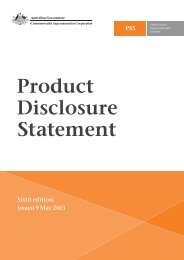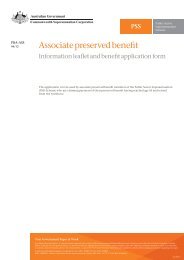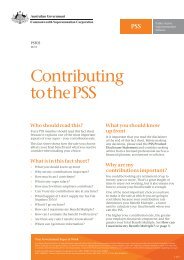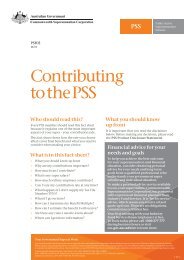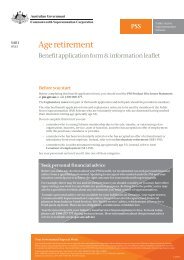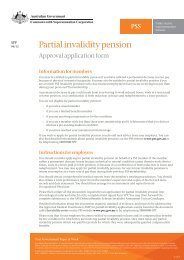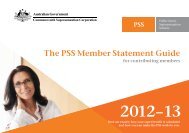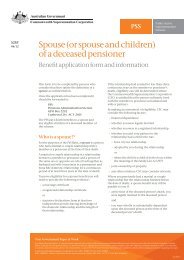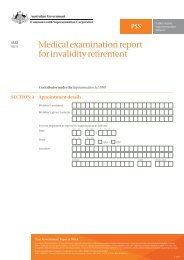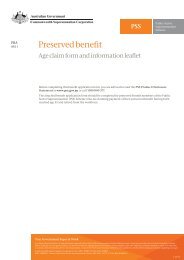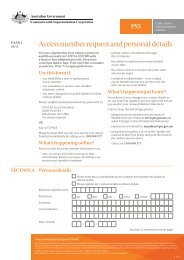Changing from full-time to part-time - PSS
Changing from full-time to part-time - PSS
Changing from full-time to part-time - PSS
Create successful ePaper yourself
Turn your PDF publications into a flip-book with our unique Google optimized e-Paper software.
PSF10<br />
07/08<br />
<strong>Changing</strong> <strong>from</strong><br />
<strong>full</strong>-<strong>time</strong> <strong>to</strong> <strong>part</strong>-<strong>time</strong><br />
Who should read this?<br />
<strong>PSS</strong> members who are considering reducing their<br />
working hours <strong>from</strong> <strong>full</strong>-<strong>time</strong> <strong>to</strong> <strong>part</strong>-<strong>time</strong>. It<br />
may also provide some useful information <strong>to</strong><br />
existing <strong>part</strong>-<strong>time</strong> <strong>PSS</strong> members.<br />
What is in this fact sheet?<br />
> > What you should know up front<br />
> > Why would I consider changing <strong>to</strong><br />
<strong>part</strong>-<strong>time</strong> employment?<br />
> > How does this affect my super?<br />
> > What options do I have?<br />
> > What do I need <strong>to</strong> do?<br />
> > Where can I get more information?<br />
What you should know<br />
up front<br />
It is important that you read the disclaimer<br />
below. Before making any decisions, please<br />
read the <strong>PSS</strong> product disclosure statement<br />
and consider seeking advice <strong>from</strong> a licensed<br />
professional such as a financial planner,<br />
accountant or solici<strong>to</strong>r.<br />
Financial advice for your<br />
needs and goals<br />
To help you achieve the best outcome<br />
for your superannuation and financial<br />
situation, consider obtaining personal<br />
advice for your needs and long-term<br />
goals <strong>from</strong> a qualified professional who<br />
understands your government super<br />
scheme and individual situation.<br />
To make a personal advice service available<br />
<strong>to</strong> you, your super trustee, Commonwealth<br />
Superannuation Corporation, has <strong>part</strong>nered<br />
with experienced financial planners <strong>from</strong><br />
Industry Fund Services. It is ‘fee for service’<br />
advice, which means you receive a fixed<br />
quote up front. There are no obligations,<br />
commissions or hidden fees.<br />
Your first meeting with your Industry<br />
Fund Services financial planner is free.<br />
To book <strong>to</strong>day please call 1300 277 777<br />
during business hours or visit<br />
csc.gov.au/advice <strong>to</strong> learn more.<br />
Your Government Super at Work<br />
Any financial product advice in this document is general advice only and has been prepared without taking account of your personal objectives, financial situation or needs.<br />
Before acting on any such general advice, you should consider the appropriateness of the advice, having regard <strong>to</strong> your own objectives, financial situation or needs. You may wish<br />
<strong>to</strong> consult a licensed financial advisor. You should obtain a copy of the <strong>PSS</strong> Product Disclosure Statement and consider its contents before making any decision regarding your super.<br />
Commonwealth Superannuation Corporation (CSC) ABN: 48 882 817 243 AFSL: 238069<br />
RSEL: L0001397 Trustee of the Public Sec<strong>to</strong>r Superannuation Scheme (<strong>PSS</strong>) ABN: 74 172 177 893 RSE: R1004595<br />
Industry Fund Services (IFS) ABN 54 007 016 195 AFSL 232514<br />
1 of 4
Why would I consider<br />
changing <strong>to</strong> <strong>part</strong>-<strong>time</strong><br />
employment?<br />
There are many reasons why you might change<br />
<strong>to</strong> <strong>part</strong>-<strong>time</strong> employment. Some common<br />
reasons include wanting <strong>to</strong> spend more <strong>time</strong><br />
with your family (especially raising children),<br />
phasing your retirement, or for health reasons.<br />
There is a misconception that the <strong>PSS</strong> acts as a<br />
barrier <strong>to</strong> working <strong>part</strong>-<strong>time</strong> or phasing your<br />
retirement. This is generally not the case. If you<br />
are thinking about reducing your hours, talk <strong>to</strong><br />
your employer about the possibility of working<br />
<strong>part</strong>-<strong>time</strong> in your organisation.<br />
This fact sheet will give you an understanding of<br />
the effect of <strong>part</strong>-<strong>time</strong> work on your <strong>PSS</strong> super.<br />
Going <strong>part</strong>-<strong>time</strong> because of ill-health<br />
If you have <strong>to</strong> reduce your working hours<br />
because of a medical condition that is unrelated<br />
<strong>to</strong> compensation payments, you may be entitled<br />
<strong>to</strong> a <strong>part</strong>ial invalidity pension. You can get more<br />
information about <strong>part</strong>ial invalidity pensions<br />
<strong>from</strong> your employer.<br />
If you reduced your hours because of a medical<br />
condition and a <strong>part</strong>ial invalidity pension was<br />
granted, your benefit accrual would continue<br />
at the <strong>full</strong>-<strong>time</strong> rate despite the fact that your<br />
contributions would be at the <strong>part</strong>-<strong>time</strong> rate.<br />
How does this affect<br />
my super?<br />
The effect on your contributions<br />
If you become a <strong>part</strong>-<strong>time</strong> employee there is<br />
no effect on your fortnightly contribution rate<br />
until your next birthday. At that <strong>time</strong>, we work<br />
out your contribution rate similarly <strong>to</strong> if you<br />
were contributing on a <strong>full</strong>-<strong>time</strong> basis. However,<br />
your contributions would be reduced pro-rata<br />
according <strong>to</strong> the number of hours you are<br />
approved <strong>to</strong> work on your birthday.<br />
Example<br />
Maria, a <strong>full</strong>-<strong>time</strong> employee is receiving a<br />
salary for superannuation purposes of<br />
$45,361. She is paying 7% of this in<br />
contributions <strong>to</strong> the <strong>PSS</strong>. Her contribution<br />
rate is worked out as follows:<br />
$45,361 ÷ 26 × 7% = $122.13 per fortnight<br />
Maria becomes a <strong>part</strong>-<strong>time</strong> employee and<br />
works 50 of her normal 73.5 <strong>full</strong>-<strong>time</strong> hours<br />
for the position. Her contributions are worked<br />
out as follows:<br />
Step 1: Work out the <strong>full</strong>-<strong>time</strong> contribution<br />
$45,361 ÷ 26 × 7% = $122.13 per fortnight<br />
Step 2: Pro-rata the contribution according<br />
<strong>to</strong> the approved <strong>part</strong>-<strong>time</strong> hours<br />
$122.13 x 50 ÷ 73.5 = $83.08 per fortnight<br />
The effect on my benefit<br />
The <strong>PSS</strong> is a defined benefit scheme and benefits<br />
are based on a number of fac<strong>to</strong>rs, including your<br />
length of membership, your salary and your rate<br />
of contribution.<br />
To work out your benefit, you must first work out<br />
your Final Average Salary (FAS). This is generally<br />
the average of your salaries on each of the three<br />
birthdays before you leave the <strong>PSS</strong>. The salaries<br />
used are always the <strong>full</strong>-<strong>time</strong> equivalent and<br />
your FAS will not be reduced if you were <strong>to</strong> go<br />
<strong>part</strong>-<strong>time</strong>.<br />
Then, you multiply your FAS by your benefit<br />
multiple. Your benefit multiple accrues<br />
according <strong>to</strong> your rate of contribution. Your<br />
benefit multiple actually grows each fortnight<br />
with each contribution you make.<br />
The following table shows the different<br />
benefit multiples that apply <strong>to</strong> different rates<br />
of contribution.<br />
Contribution rate<br />
Annual accrual rate<br />
0% .11 x FAS (or 11% of FAS)<br />
2 % .15 x FAS (or 15% of FAS)<br />
3% .17 x FAS (or 17% of FAS)<br />
4 % .19 x FAS (or 19% of FAS)<br />
5% .21 x FAS (or 21% of FAS)<br />
PSF 24 / February 2005<br />
6 % .23 x FAS (or 23% of FAS)<br />
7% .25 x FAS (or 25% of FAS)<br />
8 % .27 x FAS (or 27% of FAS)<br />
9 % .29 x FAS (or 29% of FAS)<br />
10 % .31 x FAS (or 31% of FAS)<br />
2 of 3<br />
Your Government Super at Work<br />
2 of 4
So, in Maria’s case, as a <strong>full</strong>-<strong>time</strong> employee, if she<br />
elected <strong>to</strong> pay contributions at a rate of 7% over a<br />
12-month period, her benefit multiple for a year<br />
would be 0.25 of her final average salary.<br />
Going <strong>part</strong>-<strong>time</strong> does not affect any benefit<br />
multiple that you accrued while a <strong>full</strong>-<strong>time</strong><br />
contribu<strong>to</strong>r. It may affect any future multiple<br />
accrual though.<br />
Benefit accrual for permanent <strong>part</strong>-<strong>time</strong><br />
employees<br />
If you were <strong>to</strong> go <strong>part</strong>-<strong>time</strong>, your ongoing<br />
multiple accrual <strong>from</strong> your next birthday would<br />
be reduced pro-rata according <strong>to</strong> the approved<br />
hours worked on your next birthday. The<br />
reduction does not apply <strong>to</strong> the multiple you had<br />
already accrued before your next birthday.<br />
The following formula would be used <strong>to</strong> calculate<br />
your <strong>part</strong>-<strong>time</strong> multiple accrual:<br />
Benefit multiple x<br />
<strong>part</strong>-<strong>time</strong> hours<br />
<strong>full</strong>-<strong>time</strong> hours<br />
Therefore, if Maria’s <strong>part</strong>-<strong>time</strong> hours (as<br />
approved at her last birthday) were 50 hours<br />
a fortnight, and her <strong>full</strong>-<strong>time</strong> hours for that<br />
position were 73.5 hours per fortnight, the yearly<br />
multiple accrual would be:<br />
0.25 × 50 ÷ 73.5 = 0.17<br />
Calculation of benefit multiple<br />
The following examples show the effect that<br />
working <strong>part</strong>-<strong>time</strong> has on the accrual of your<br />
benefit multiple. Maria retires after 30 years’<br />
membership. Her FAS is $45,361.<br />
In Example 1, Maria worked <strong>full</strong>-<strong>time</strong> for the<br />
length of her membership. During this period<br />
she contributed 5% for 10 years, 6% for 15 years<br />
and 7% for five years.<br />
In Example 2, Maria worked <strong>full</strong>-<strong>time</strong> for 25<br />
years, contributing at rates of 5% for 10 years and<br />
6% for 15 years. She also worked <strong>part</strong>-<strong>time</strong> (50<br />
hours per fortnight) for five years, during which<br />
<strong>time</strong> she paid 7% in contributions.<br />
Maria’s lump sum benefit would be worked out<br />
as follows:<br />
Example 1<br />
10 years × 0.21 (see table above) = 2.10<br />
15 years × 0.23 (see table above) = 3.45<br />
5 years × 0.25 (see table above) = 1.25<br />
Total Benefit Multiple = 6.80<br />
6.80 × $45,361 (FAS) = $308,455<br />
Example 2<br />
10 years × 0.21 = 2.10<br />
15 years × 0.23 = 3.45<br />
5 years (<strong>part</strong>-<strong>time</strong>) × 0.17 = 0.85<br />
Total Benefit Multiple = 6.40<br />
6.40 × $45,361 (FAS) = $290,310<br />
Does going <strong>part</strong>-<strong>time</strong> affect invalidity<br />
and death benefits?<br />
In the <strong>PSS</strong>, you generally have au<strong>to</strong>matic<br />
invalidity and death cover. In some situations,<br />
you can also purchase additional death and<br />
invalidity cover.<br />
Your au<strong>to</strong>matic cover consists of your current<br />
benefit accrual plus a prospective element that is<br />
calculated as if you had continued <strong>to</strong> contribute<br />
until your 60th birthday. Going <strong>part</strong>-<strong>time</strong><br />
may reduce the prospective element of your<br />
death and invalidity benefit in addition <strong>to</strong> the<br />
reduction in your ongoing accrual.<br />
What options do I have?<br />
As a <strong>part</strong>-<strong>time</strong> employee, you can elect <strong>to</strong><br />
change your contribution rate in the same way<br />
as you can when you are a <strong>full</strong>-<strong>time</strong> employee.<br />
However, you cannot elect <strong>to</strong> continue paying<br />
<strong>full</strong>-<strong>time</strong> contributions.<br />
If you are reducing your hours due <strong>to</strong> health<br />
reasons, you may be entitled <strong>to</strong> a <strong>part</strong>ial<br />
invalidity pension. You will need <strong>to</strong> talk <strong>to</strong><br />
your personnel section <strong>to</strong> discuss this option.<br />
What do I need <strong>to</strong> do?<br />
If you would like <strong>to</strong> reduce the hours that you<br />
are working, contact your employer for more<br />
information.<br />
If you do go <strong>part</strong>-<strong>time</strong>, there is nothing you<br />
would need <strong>to</strong> do in relation <strong>to</strong> your <strong>PSS</strong> super.<br />
Your employer will provide details of your<br />
<strong>part</strong>-<strong>time</strong> hours and we will au<strong>to</strong>matically<br />
reduce your contributions <strong>from</strong> your next<br />
birthday provided that you are still working<br />
<strong>part</strong>-<strong>time</strong>.<br />
As contributions would remain at the <strong>full</strong>-<strong>time</strong><br />
rate until your next birthday, you may wish<br />
<strong>to</strong> reduce your rate of contributions <strong>to</strong> give<br />
you a little more take home pay. Remember<br />
though, that any reduction in the rate of your<br />
contributions affects the amount of multiple<br />
that you are accruing.<br />
Your Government Super at Work<br />
3 of 4
Where can I get more<br />
information?<br />
The <strong>PSS</strong> website also has the i-Estima<strong>to</strong>r. The<br />
i-Estima<strong>to</strong>r is a handy online <strong>to</strong>ol that enables<br />
you <strong>to</strong> estimate your future super benefits. You<br />
will need <strong>to</strong> have your Access Number* <strong>to</strong> use<br />
the i-Estima<strong>to</strong>r.<br />
*To get an Access Number, call us on<br />
1300 000 377 and we can provide one over<br />
the phone.<br />
EMAIL members@pss.gov.au<br />
PHONE 1300 000 377<br />
FAX 02 6272 9613<br />
MAIL<br />
WEB<br />
<strong>PSS</strong><br />
GPO Box 2252<br />
Canberra ACT 2601<br />
pss.gov.au<br />
email<br />
phone<br />
financial advice<br />
post<br />
members@pss.gov.au<br />
web<br />
www.pss.gov.au<br />
1300 000 377<br />
overseas callers<br />
+61 2 6272 9622<br />
1300 277 777<br />
fax<br />
(02) 6272 9613<br />
<strong>PSS</strong><br />
GPO Box 2252<br />
Canberra ACT 2601<br />
4 of 4


